Aztec Music
To the Aztecs, music and poetry were serious business. It was a powerful way to communicate with the gods and keep the universe in balance. They called this whole idea in xochitl in cuicatl , ‘the flower and the song,’ and it was part of everything in their culture.
The Big Deal About Music
A Present from the Sun God
The Aztecs believed music was a gift from the gods, sent to an earth that was way too quiet. The story goes that the god Tezcatlipoca thought the world was beautiful but silent. He figured only music could make people truly happy.
So, he sent another god, Quetzalcóatl, on a mission to the Sun’s house. A whole band of divine musicians lived up there, making awesome music all day. Quetzalcóatl's job was to convince them to come down to earth.
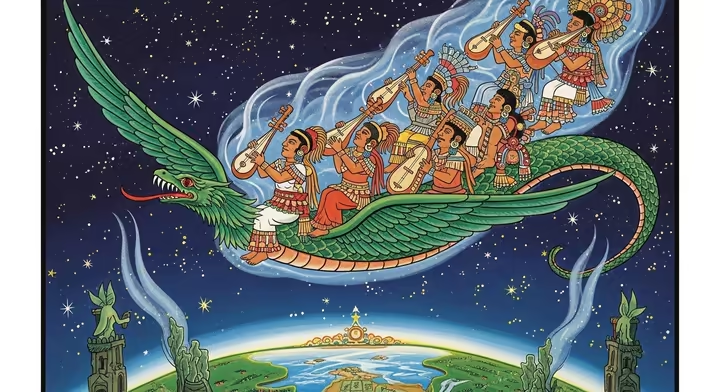
The musicians were a bit scared at first, but Quetzalcóatl brought them down safely. Once here, they taught music to people, animals, and even the wind and rain. This is why all earthly music was seen as an echo of the perfect, happy music from the heavens.
Keeping the Beat of the Universe
The Aztecs believed in teotl , a sacred energy that was in everything. It was a force, always moving between opposites like life and death, light and dark.
Their big challenge was how to stay balanced on the ‘slippery earth’. Music and dance were their main tools for getting in sync with the rhythm of teotl .
You can see this idea in their most sacred drums. The tall huehuetl drum had a low tone and a high one. Its partner, the teponaztli log drum, had two wooden ‘tongues’ that made two different notes, and these instruments were considered living gods.
Flower and Song
The Aztecs didn't have a single word for ‘music’. Instead, they used a phrase that meant ‘the art of song’. They didn't ‘play’ instruments, they ‘sang’ on them, and dancing was ‘singing with the feet’.
This all came together in the idea of in xochitl in cuicatl , ‘the flower and the song’. To them, the everyday world was like a dream, and only through ‘flower and song’ could you touch something real and true.
The ‘flower’ stood for life's beauty, and the ‘song’ was poetry and sound. A Spanish priest, Diego Durán, first thought the native songs were nonsense. But after someone explained the clever meanings, he was amazed by how deep they were.
The Instruments
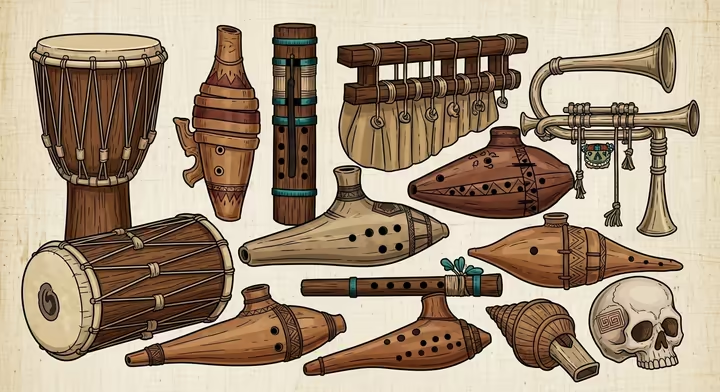
The God-Drums
The two main drums were the huehuetl and the teponaztli . The Aztecs treated these instruments like gods. They were sometimes even ‘fed’ with blood from sacrifices.
The huehuetl (weh-weht) was a tall, upright drum made from a hollow log with a deerskin top. Drummers hit the center for a deep bass tone and the rim for a higher one.
Its partner was the teponaztli (tay-po-nawtz-lee), a horizontal log drum with two carved wooden tongues that made different notes. Together, these drums were the sacred heartbeat of the empire.
Flutes, Trumpets... and Screams
The Aztecs had a bunch of wind instruments that could sound sweet or terrifying. The most common were the huilacapitztli , a general name for different flutes and ocarinas made from clay, bone, or wood. They played the melodies for everything from love songs to temple ceremonies.
Then you had the conch shell trumpet, or tecciztli . These were real sea shells, and their powerful blast was used by priests to announce sacrifices or to scare enemies in battle.
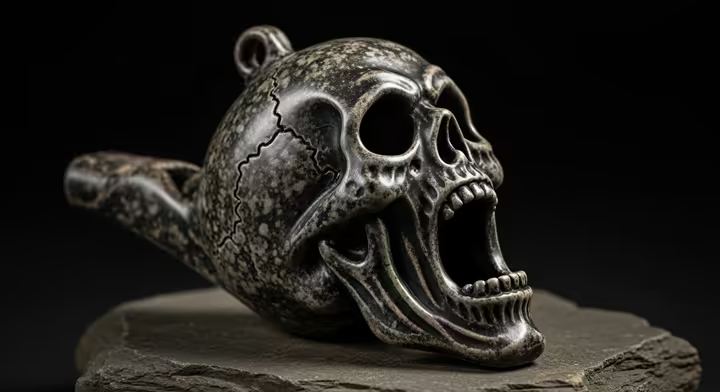
But maybe the creepiest Aztec instrument is the ‘death whistle’, or ehecachichtli . These small clay whistles, often shaped like skulls, make a horrifying sound like a human scream. They were probably used in sacrificial rituals to copy the sounds of Mictlan, the Aztec underworld.
Shakers and Scrapers
The rest of the Aztec orchestra was filled with rattles and other noisemakers. Gourd rattles ( ayacachitl ), filled with seeds or pebbles, were used everywhere.
They also used turtle shells ( ayotl ) as drums, hitting them with a deer antler to make a clattering sound. Rasps made from notched bones (sometimes human ones!) made a grating noise for funerals. Even the priests' incense ladles had rattles on them.
| Instrument Name (Nahuatl/Common) | Type | Made Of | How It Sounded & Was Played | Why It Was Important |
|---|---|---|---|---|
| Huehuetl | Drum (Membranophone) | Hardwood log, animal skin (ocelot, deer) | Tall upright drum played with hands. Makes a low tone (center) and high tone (rim). | The empire's sacred heartbeat. Treated as a god. Used in rituals and to start battles. |
| Teponaztli | Slit Drum (Idiophone) | Hardwood log | Horizontal log drum with two 'tongues'. Played with rubber mallets to make two notes. | A sacred god-instrument. Paired with the huehuetl for dance, poetry, and war. |
| Tecciztli (Conch Trumpet) | Trumpet (Aerophone) | Large conch shell | Buzzed into like a trumpet. Makes a loud, powerful, single-note blast. | Linked to creation and water gods. Used to announce ceremonies and scare enemies in battle. |
| Ehecachichtli (Death Whistle) | Whistle (Aerophone) | Clay, sometimes bone | Internal chambers make a chaotic, wind-like sound, like a scream or howl. | Linked to wind and death gods. Used in sacrifice rituals and psychological warfare. |
| Huilacapitztli (Flutes/Ocarinas) | Flute (Aerophone) | Clay, bone, wood | Huge variety of shapes and sizes. Often tuned to a five-note scale. | The main melody instrument. Used for everything from private worship to huge ceremonies. |
| Ayacachitl (Gourd Rattle) | Rattle (Idiophone) | Dried gourd, seeds, pebbles | Shaken for a sharp, rattling sound. | A common rhythm instrument that added texture to music for festivals and worship. |
| Ayotl (Turtle Shell Drum) | Struck (Idiophone) | Turtle shell, deer antler | Shell is struck with an antler for a hollow, clattering sound. | Used in specific ceremonies, often shown in ancient books. |
| Omichicahuaztli (Bone Rasp) | Scraped (Idiophone) | Notched bone (animal or human) | Scraped with a stick to make a dry, grating noise. | Used for funerals and ceremonies about grief and the earth. |
Music for Every Occasion
So, What Was the Vibe?
No written music survived, so we have to guess. The melodies were probably based on a five-note (pentatonic) scale, which is common in ancient music all over the world.
Rhythm was king. They even had a way to write it down using drum sounds, like To , Ko , Ti , and Ki , to show different beats. This tells us their rhythms were pretty complex. A full Aztec band would have been LOUD, mixing thumping drums, wailing flutes, and blaring conch shells, the same kind of energy that powered Aztec games and ceremonies across the empire.
Dancing as Prayer
For the Aztecs, music and dance were the same thing. To dance was ‘to sing with the feet’. During big festivals, thousands of people would dance together in perfect sync in the main plazas.
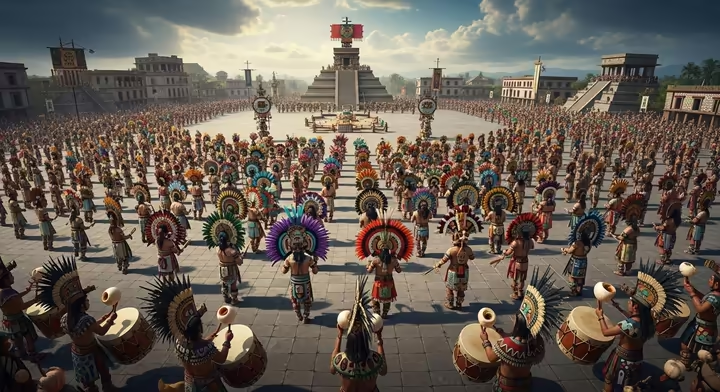
This was a kind of moving meditation. The repetitive steps were meant to put dancers into a trance to connect with the gods. The moves themselves meant something, a snake-like wiggle for fertility or a zigzag for water.
Dancers also wore amazing costumes with bright feathers, and attached bells and shells to their clothes. This turned their whole body into another instrument.
Mandatory Music Class
The government made sure everyone learned music. Every Aztec kid, rich or poor, had to go to the cuicacalli , the ‘house of song’, around age 12. There they learned all the important songs and dances that held their culture together.
Noble kids went to elite schools called the calmecac . Here, future leaders learned history, law, and how to compose high-class poetry and music. The best musicians became pros, working in palaces to write songs about military victories.
War Music
In the Aztec world, ritual and war were linked, and music was a weapon. The Aztec army marched behind a ‘wall of sound’ made to terrify the enemy before a fight even started.
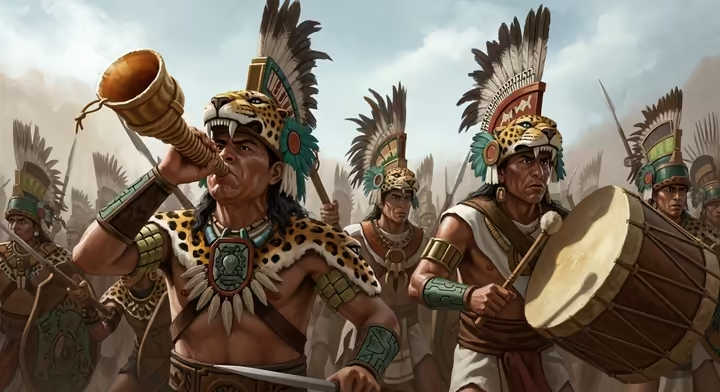
Blasts from a conch shell trumpet could send commands across the battlefield. Drums, sometimes carried on the ruler’s back, would signal an attack.
But mostly, the noise was about fear. Spanish soldiers described a terrifying, non-stop racket of drums, horns, and whistles. The main instrument of terror was the death whistle, whose shriek sounds like a human scream and is scientifically proven to be deeply scary.
Does Aztec Music Still Exist?
After the Spanish Arrived
When the Spanish came in 1521, they hated the local music. The Spanish friars thought it was devil worship and tried to wipe it out. They banned the sacred drums and replaced the old songs with Christian hymns.
The old music adapted instead of disappearing. When native instruments were banned, people got creative. The Concheros dance tradition, for example, swapped the sacred drums for guitars made from armadillo shells, but kept the spiritual meaning.
Modern Echoes
You can still hear bits of Aztec music in Mexican folk styles today. A good example is son jarocho from Veracruz. The music is played at a fandango , a community party where people gather in a circle, similar to old Aztec ritual dances.
The main rhythm comes from the zapateado , a stamping dance on a wooden platform. The platform probably replaced the banned drums, with the rhythms moving from the hands to the feet.
Science to the Rescue
Today, scientists are using a field called archeoacoustics to bring Aztec sounds back to life. They study the physics of the instruments to hear how they actually sounded.
Using 3D printing, they can make perfect, playable copies of old, fragile instruments. This has been a huge help for figuring out how complex things like the death whistle actually worked.
They're even doing brain scan studies and have found the death whistle's shriek triggers fear centers in the brain. Through a mix of history, art, and science, the silent artifacts of the Aztec Empire are starting to sing again.